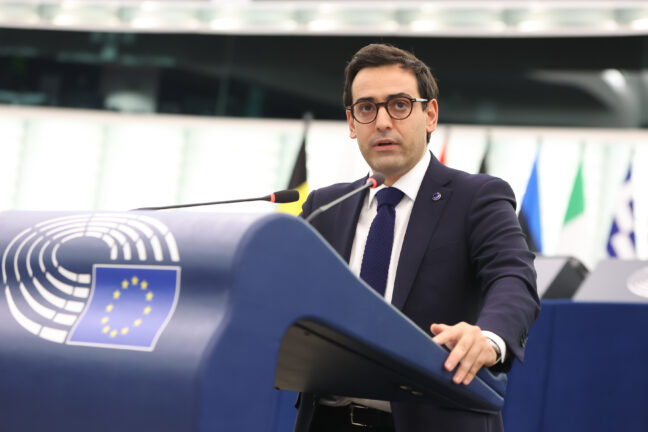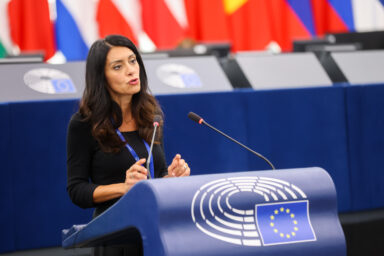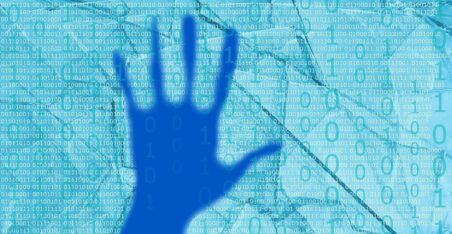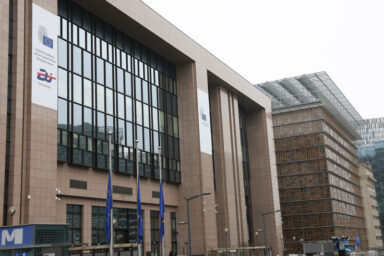The European Union is developing a plan to limit its reliance on Chinese critical raw materials, taking a leaf from Japan’s book, Commission Vice-President Stéphane Séjourné’s cabinet told EU Perspectives. He elaborated on President Ursula von der Leyen‘s criticism of Beijing for its expanded restrictions on the export of rare earths.
Less than one week after an emergency meeting with representatives of European industries, the European Commission announced a new EU plan, known as RESourceEU, to secure raw materials supply. This follows China’s newly enacted measures to limit the export of rare earths and related technologies.
“(Among other things,) we will create a joint purchasing and strategic stockpiling centre for critical raw materials, inspired by the Japanese model. What we did for health with the Covid-19 vaccine, we can do for our economic and national security with raw materials,” Commission Vice-President (and prosperity commissioner) Stéphane Séjourné said.
Acceleration necessary
On Monday 20 October, Commission Vice-President (and prosperity commissioner) Stéphane Séjourné held an emergency meeting with the representatives of a number of industries – from automotive to defence and space, including companies such as Safran or Airbus. Later, the Commissioner “had already ordered internal assessments and looked into ways of accelerating planned European initiatives on critical raw materials”, his cabinet told EU Perspectives.
At the beginning of the month, Beijing announced different new export control measures for rare earths and related technologies. In particular, this concerns restricting exports of related technologies and know-how and imposing licensing requirements on foreign firms.
You might be interested
In response to Beijing’s move, Ms von der Leyen said on Sunday 19 October that the EU would seek to speed up critical raw materials partnerships with countries such as Australia, Canada, Chile, Greenland, Kazakhstan, Uzbekistan and Ukraine. The scheme, called RESourceEU, would be similar to a plan the EU developed after Moscow’s 2022 invasion of Ukraine to cut its reliance on Russian energy, known as REPowerEU, she said.
‘Focus on everything‘
“We will focus on everything from joint purchasing to stockpiling. We will boost investment in strategic projects for the production and processing of critical raw materials here in the European Union,” the Commission president said. “If you consider that over 90 per cent of our consumption of rare earth magnets comes from imports from China, you see the risks here for Europe and its most strategic industrial sectors.”
As Global Trend Alert reported: “For the first time, Beijing is asserting jurisdiction over foreign-made products that contain or are manufactured using Chinese-origin rare-earth materials” and “now requires overseas firms to obtain export licences from the Chinese Ministry of Commerce”. In other words, this shift signals “a transition from managing commodities to governing strategic technologies, embedding export controls within China’s broader security and industrial policy agenda”, Global Trend Alert underlined.
Both a diplomatic solution and a more reliable supply chain (are necessary), with key role to EU production and new reinforced partnerships with third countries — the cabinet of Stéphane Séjourné, European Commission Vice-President and prosperity Commissioner
For the EU, the industries most affected after this Chinese shift are automotive (Forvia, Volkswagen, Stellantis); wind power (Vestas, Siemens, Enercon); semiconductors (Bosch); chemicals (Solvay); mining ad processing industry in connection with European-labeled projects (Vaccumschmelze, Magneti Ljubljana, MagREEsource, Neoperformance, SMK, Umicore), and defence and space (Airbus, Safran).
Not a uniform solution
After one hour of meeting to assess the current and future effects of restrictions on every sector of the industry, it emerged that it will be essential “requiring specific solutions which renders a one-fits-it-all short-term solution unlikely”, Mr Séjourné‘s cabinet said.
The commissioner then presented the findings of the exchange in Strasbourg to the relevant commissioners meeting in a project group. The EU “is preparing different courses of action including joint purchasing and stockpiling or measures on scrap” because “we needed to act on several levies at the same time”, his cabinet said.
From the technical point of view, among industries there is the consensus on the necessity “to accelerate our derisking strategy on CRM in the medium to long-term” and EU suppliers stressed their readiness to participate in this effort. On the political side of the story, from what Commissioner Séjourné’s cabinet said, there has also been a consensus on the need of a balanced response on two key pillars. Those are “both a diplomatic solution and a more reliable supply chain, with key role to EU production and new reinforced partnerships with third countries,” the cabinet said.
Japan’s plan
Mr Séjourné and other EU officials have mentioned Japan’s plan designes to address similar China-related raw materials issues. What does it look like? In short, it combines international partnerships, technology investment, and domestic initiatives. A cornerstone of the strategy is diversifying supply sources through investments in overseas mining and processing projects.
For example, Japanese companies have stakes in the Lynas Corporation’s rare earth processing plant in Malaysia, which is one of the largest rare earth suppliers outside China. They also invest in lithium production facilities in Argentina, securing vital inputs for electric-vehicle batteries and renewable energy technologies.
We will create a joint purchasing and strategic stockpiling centre for critical raw materials, inspired by the Japanese model. — Stéphane Séjourné
Simultaneously, Japan commits to technological innovation by funding research into recycling rare earths and developing alternatives to scarce minerals. This includes promoting a circular economy approach to recover critical materials from end-of-life products. While commercial-scale recycling is not yet widespread, Japan expects these efforts to become more significant by the 2030s, reducing long-term dependency.
Strategic stockpiling
Another important pillar is strategic stockpiling. After earlier supply shocks caused by geopolitical tensions, Japan encouraged companies to accumulate reserves of rare earths as a buffer against sudden disruptions. This approach has since been refined to avoid market distortions while ensuring resilience.
Japan also focuses on strengthening supply chain resilience through international cooperation, including ongoing dialogues with allies and partners to promote transparent, stable sourcing and investment in critical mineral projects.
This multipronged approach—combining diversification, innovation, stockpiling, and diplomacy—aims to break China’s near-monopoly over critical minerals that underpin Japan’s high-tech industries, from electronics to clean energy, and secure a stable supply for the future.







